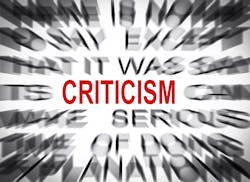Talent Advisory Board: How to Give and Get Constructive Criticism
The IndustryWeek Talent Advisory Board offers monthly advice on how its members got to where they are in the manufacturing world. If you have a question for the group, please send it to [email protected]. This month's question was:
Understanding that you’re doing something wrong or need to improve your performance is critical to advancing in a career, but as much as many people need constructive criticism, it can still hurt. What was a memorable moment that you had in receiving negative comments about your performance, and how did that experience inform how you give criticism to employees who need to hear it?Sorry Ted Lasso Fans, No Compliment Sandwiches
Despina Anastasiou, Global Business Development Director for Global Strategy, Dow
Over my many years of experience, I have also found how we frame feed-back versus feed-forward and the timeliness of guidance and when it is given is also critical. Similarly, poorly chosen language we often use to convey the message of strengths and weaknesses can also be polarizing.
So, a succinct response to what you are asking is to reword what I prefer to hear and also as a leader or peer give to others. This includes:
- What am I doing well that I should continue to amplify?
- What am I doing that I could consider doing differently? May I have an example….?
- What is best in class performance or someone you would recommend I observe and learn from? Note that this is particularly important when new to a role/group/function/geography.
The thought leadership and books which I consider timeless in their guidance on performance and growth include “The Right and Wrong Stuff” by Carter Cast and “What Got You Here, Won’t Get You There” by Marshall Goldsmith.
Guiding Employees to the Answers
Carlos Torres, Head of Industry 4.0 at USA 5G Smart Factory, Ericsson
When providing feedback, at a minimum, it should be specific, timely and actionable. Even better, feedback from a great leader focuses on growth and empowerment. Feedback should be a collaborative two-way conversation rather than a monologue that lacks open-ended questions with no room for assessment.
Instead of saying “You didn’t meet the deadline,” you could ask, “What factors do you think contributed to the delay.”
A technique I often use is to think of myself as a guide to answers, as opposed to an answer provider. This allows me to encourage employees to seek solutions and empower them to take ownership of their growth.
Keep it Short, Keep it Actionable
Paul Baldassari, Executive Vice President of Worldwide Operations, Flex
While it might be more work to craft a short, concise message, feedback is so much more actionable when you share one or two examples to help explain what is not working.
When I received that actionable feedback, I really took it to heart. Now when I provide feedback, I believe that I owe it to the person to take the time to be clear in my mind, I don’t talk around the issue, and I provide actionable feedback. I also try to offer help if the recipient is open to it.
Error/Error
Rebecca Morgan, President, Fulcrum ConsultingWorks Inc.
Early in my career, I was a very bright member of a very strong team that enjoyed our work together. Early one morning I, as well as the entire team, heard our boss singsong the word ‘er-ror’ two or three times. Knowing he was reviewing my work, I quickly appeared in front of him, if only to quiet that friendly but embarrassing singsong.
He showed me the error I had made and explained what I should have done better. As I turned to leave his office he quietly and kindly said the obvious: We all make mistakes. Every one of us. Mistakes give us the opportunity to learn. And teach. Now you can take this opportunity to show the rest of the team how to do this better.
I walked out to my team and kindly explained my mistake to them.
My self-confidence, realigned with a healthier psychology, enabled each of us to see mistakes were part of performing complex work, not a sign of failure or weakness.
My boss could pull this off well because of the culture he had created within our group. In an unhealthy environment this would have turned out quite differently.
There is no one way to provide feedback. Or to deal with it. My former boss’s approach worked perfectly for me, our team, and our culture.
A Path to Improvement
Tami Wolownik, Head of People & Organization, North America, at Siemens Mobility
Prior to my career at Siemens Mobility, one situation stands out which has guided my current approach to giving constructive criticism.
I was managing a very large department at the time, and I would frequently go to my manager complaining when issues with another department would negatively impact my team. That manager eventually asked me if I had tried to resolve the issue myself, and why I couldn’t come to him with a review of the situation, three possible actions to resolve it and my recommendation on the best path forward. In essence, the feedback was: I needed to own or at least participate in brainstorming for a solution instead of just raising the problem for someone else to handle.
This feedback really stuck with me. I thought I was being proactive at the time by raising my concerns right away, but I was failing to think about my role in finding a solution. My manager’s criticism helped me to focus on taking ownership to improve relationships as opposed to building barriers.
Now, I not only do that, but I also coach employees who come to me with complaints to do the same. Your teams will feel better when they are part of a solution, rather than just posing a problem.
When giving constructive criticism more generally, I also use my old manager’s approach of giving employees actionable feedback. If an employee isn’t doing something right, don’t just criticize, but lay out the steps of how to improve going forward.
About the Author
IW Talent Advisory Board
An expert panel of manufacturing leaders offering advice on how to advance your career.
Beginning a career in any industry is challenging, and many people early in their journeys in manufacturing need advice on how to advance and reach the next milestone. IndustryWeek’s Talent Advisory Board collects manufacturing leaders who rose through the ranks and are happy to share stories and advice on how they got to where they are now. This group includes senior-level people and young leaders who advanced quickly in their organizations. They work for large companies or run their own businesses, representing a wide swathe of careers within manufacturing.
Every month, we ask the group a new question about their careers or life experiences. If you have a question for the group, please send it to IndustryWeek [email protected].





